Illustration: Noah MacMillan
Editor’s note: This season, Timbers.com and Howler Magazine are collaborating on a series that will explore soccer in Portland and the city’s influence on the game in the United States. This story, the first in the series, looks at the ways that fans transform Providence Park into a crucible for the creation of public art.
------------
The freshly painted canvas smells foul, like bitter herbs and turpentine. Its aroma fills the empty North End of Providence Park, where the Timbers Army tifo committee is rigging the ropes that will hoist their giant banner to the roof at the beginning of tomorrow’s match, the first of the 2015 season, against Real Salt Lake. A tifo is a large banner that displays a message and often artwork from a group of fans. Mess up the unveiling and the message gets lost.
“If you want to be Timbers Army, you already are,” goes the slogan of Portland’s most fervent group of supporters. But if you want to pull off something amazing, if you want to raise a great sail painted with words of encouragement for your team and your city, you rehearse. And rehearse again. Everyone wants this to go off perfectly when more than 20,000 fans, the players, and the TV audience are watching.
It looks like a Broadway crew prepping for opening night. Outside on the pavement along West Burnside St., still more than 24 hours before kickoff, a half-dozen tents shelter those who want to secure their places at the very front of the general admission section at the North End, where the singing is loudest. The game will be the main attraction, but up in the stands, the audience always puts on a performance of its own.
In soccer we talk of a player’s artistry. A particularly crafty midfielder is a maestro, the game itself beautiful. These sayings are cliché, to be sure, but their presence in the lexicon of the game casts it in aesthetic terms that most soccer fans never question. But what about acts of creation and performance that take place on the periphery—the depiction on a tifo, the rendition of a tune?
Marc Bamuthi Joseph says you can call that art, too—a kind of folk art. “It’s about more than the team,” he says. “It’s about region, geography, and a certain kind of civic pride which politicizes both sport and art in a very irreverent way.”
Joseph is chief of programming and pedagogy at the Yerba Buena Center for the Arts in San Francisco. He is also the author of /peh-LO tah/, a Balinese-style shadow play that examines global economies and sexual identities through the lens of the World Cup.
The tools of creativity are more available than ever before but in modern Western society, opportunities for “moments of collective art making” are exceedingly rare. He cites Burning Man, the desert festival where costume, tinkering, and radical self-reliance are elevated to an artform that is both high and popular. Other than that, the stadium is one of the most reliable venues for public art that we have left.
Specifically Providence Park on a Timbers’ game day.
“I’ve seen a lot of tifos and MLS games,” Joseph says, “but the difference with the Timbers is that the connection to the land makes it an act of folk creation. If they weren't called the Timbers—if they were the Portland Gigabytes—the art would look very different.”
The leaders of the Timbers Army may not be aware, or care, that they’re slyly re-creating new contemporary art styles, but they do consciously foster an atmosphere that is fertile for making something: whether that’s a comment on the other team, or a three-story image, or just a lot of noise.
A good tifo contains a touch of narrative.
For example, the 2014 season opening game tifo depicted a massive representation of the iconic Portlandia statue—no, not the television show—but rather the large bronze arch goddess that kneels over the entrance to The Portland Building downtown.
Astride her in The North End was an excerpt from the Ronald Talney poem that accompanies the real statue downtown:
This is how the world
knows where we are.
After both club and supporters established themselves as one of the most vibrant soccer experiences in North America, the tifo became a representation of civic culture. It places the event as well as presence of the supporters as part of the story of the city and the game.
The tifos adhere to a handmade aesthetic that pervades the Timbers Army. (Its capos don’t use megaphones, for instance, as those of many other teams do.) They hold this up in contrast to the “printed” feel of their biggest rivals. Although digital files are used in creation and projection, the tifos themselves are sewn and painted by hand. The result is more Etsy than Adobe. Smudges are okay, so long as they can’t be seen from more than five feet.
“We want to keep it authentic,” says Scott Van Swearingen, a member of the Timbers Army tifo committee and president of the 107 Independent Supporters Trust (107ist), the organizing element of the Timbers Army. He can’t help but take a jab at Seattle’s ECS [Emerald City Supporters]. “We don't want ours to look like it’s from Kinko’s.”
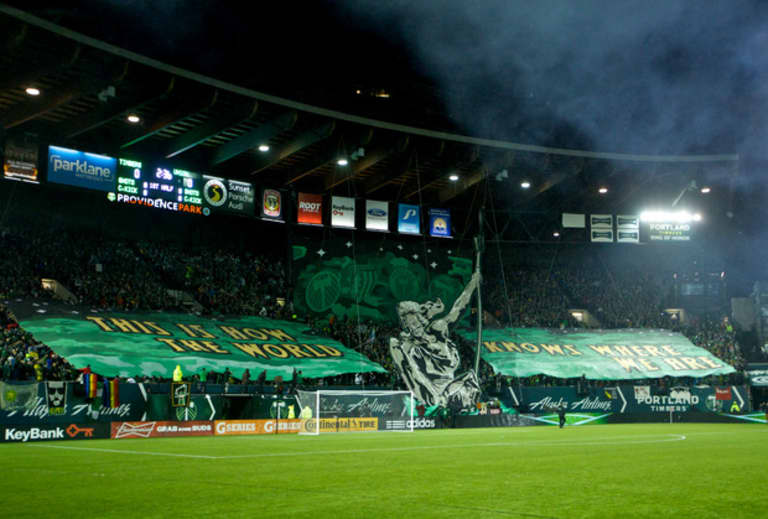
The capos—a term borrowed from Italian ultras groups where it means captain—lead the crowd with oversized gestures. Milo Reed, recently promoted to capo, contorts his face to raise the energy of all those fans looking back at him. He came out of Chicago and punk rock, but he got into the Timbers while living in Mississippi, where he followed their USL games online. He belongs. By the time Liam Ridgewell and the rest of the Timbers walk out for warmups, he’s going full throttle.
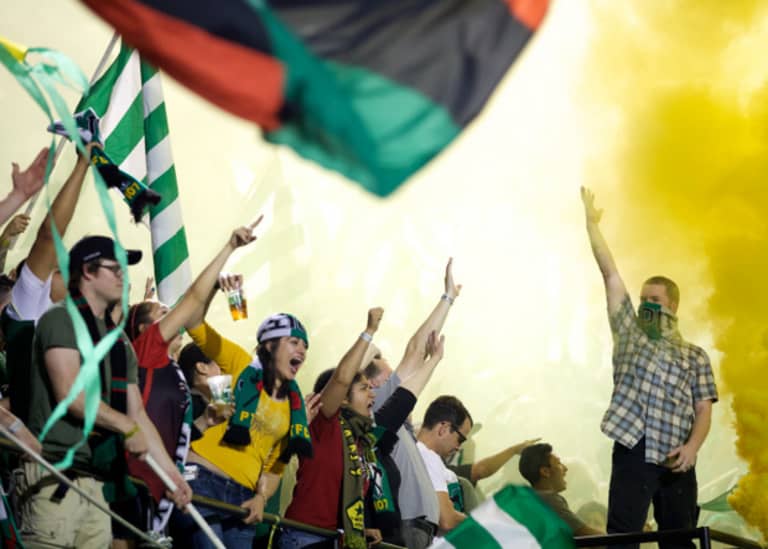
The closest thing to the spectacle created by the Timbers Army on game day is the atmosphere of college sports. The chants, costumes, and rushing the field at a university football game have the same youthful spontaneity and amateur passion. It’s messy and loud. If you just want to watch the game, there are seats in other parts of the stadium for that.
After goals by the home team, smoke bombs send towering drifts throughout the North End. (The spent bombs are, of course, despatched into fire marshal-approved buckets attached to the capo stands. Safety first.)
Dressed in their match uniforms, the players emerge from the tunnel and splay out in a line at midfield. As they always do on opening day, the fans lead the national anthem: high, fast, and joyful. It always ends with, “…and the home of the TIMBERS!” at which point the members of the tifo crew grab the ropes and begin to hoist.
Today’s tifo is a series of “cards” made of pliable vinyl held up by fans in their hands to form green and yellow chevrons; a large, silky flag with the Timbers crest from 40 years ago; and a long banner that reads “May we face and endure every winter with spring”—an obscure line from Governor Tom McCall’s 1975 farewell address to the Oregon legislature.
Slowly, a 60-foot painting of a 40oz bottle of beer—a symbol of the city—is hoisted nearly to the roof. The label reads “Cheers to 40 years.”
Two and a half minutes later, the tifo is drawn down and bundled into a dead zone behind the wheelchair section. After the game, hundreds of small flags will be stored in a dusty lock-up high atop the North End section. Weeks of brainstorming, tracing, painting, and sewing are over in a moment. The tifo will be repurposed, its canvas re-painted or cut up and sewn into tote bags.
But there’s no time to mourn. Down on the field, the players run to their positions, jacked for the game. Some of the tifo crew turn into capos. A roar echoes off the North End’s glu-lam rafters: “P-T-F-C.”
A tifo is the idea of an individual, made by a few dozen, and staged by thousands. But the Timbers Army’s next performance draws from a different artistic tradition.
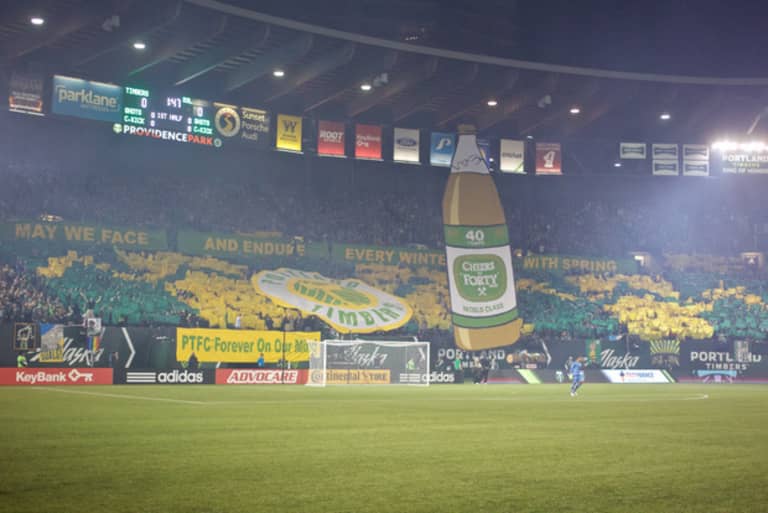
The fans who get in early have been singing for two hours by kickoff. The capos usually save their own voices and leave them to it, joking with them or maybe introducing a new song. Come game time, however, it’s the capos’ job to sustain the crowd's energy for another two hours. They take control. The RSL game was typical. To start the next song, a leader such as Camden Murray sends hand signals to Epic, the big drum, which keeps time with an ominous bass tone. The capos are ranged along the front barrier from the goal to the east side corner flag. They signal to each other across the section and get the fans singing in time.
Much like a conductor in front of an orchestra, it’s an effort in synchronization.
“My mistake early on was keeping my hands by my side," says Reed. "But it’s like theater acting versus television. It's big gestures, you have to be visible from far away."
Picking the next song is a mixture of reacting to the soccer and what the fans are feeling. "There's this tension between taking control and letting chaos reign," Reed continues. "A lot of us grew up playing in rock bands, and it's a lot like that, improvising.”
For “North End Noise,” the capos divide the fans into two groups. It’s less rock, more gospel—a call and response that whips the crowd into a frenzy.
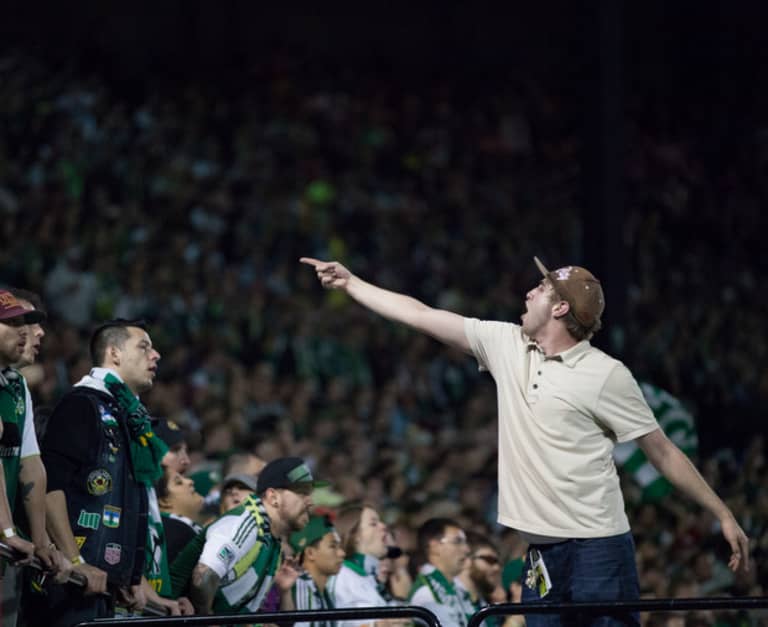
GROUP ONE: So who are we?
GROUP TWO: So who are we?
G1: We are the boys! / G2: We are the boys!
G1: We’re from the North End
and we’re here to make some noise!
G2: Make some noise!
The payoff is a great chorus and a binge of flag waving.
All: We’re gonna jump and clap and sing for victory!
And when we do… you’ll know that noise
Came from the North End Portland Timbers Army Boys
Oh Rose City, oh Rose City
This is our team, the mighty P-T-F-C!
“The Timbers Army originated with people standing around singing English-style chants,” Murray explained. “And then it got more South American and Eastern European-influenced and it became its own thing.”
The English style of singing—spontaneous but disorganized—often spreads haphazardly, with groups singing a few seconds behind each other.
“It creates an echoing, round sound, which is cool, but ours is more like South America or Eastern Europe,” he says. “We try to get the entire section the same beat.”
The Timbers Army also prides itself on being different. Like any great artist, they appropriate, but do so discriminately, sourcing their songs not from the most popular traditions but some of the more obscure.
"We take things from the far reaches of the world that people wouldn't necessarily look to and inject them into MLS,” Murray says. “'Bury Me in Green and Gold' is a Moroccan tune. 'Keep it Up Rose City' comes from Kashima Antlers in Japan. The Timbers Army has a lot of people who support obscure leagues."
-----------
Safety comes first in modern stadia, so mass movement controlled by the fans can feel like rebellion. When Marc Bamuthi Joseph says that the Timbers Army exhibits some of the characteristics of a flash mob, a big mass of people who descend on a public space in order to strike up a lightning performance, he’s talking about something like Tetris. “It's got that same level of choreography,” he says. “Art takes rehearsal.”
Tetris is an amazing sight: almost the entire end shuffling side to side, jumping, and—screw grammar—chanting, “Portland Timbers, we adore you / Portland Timbers, for you I sing!” The movement and melody gets faster and faster like in the classic video game.
“It used to be, three or four years ago, we'd do it four or five times a match,” Murray says. “But when you have that many people...and trying to watch the match, it almost becomes a distraction, so we pared it down.”
These days, he says, it’s almost entirely reserved for late in games that look headed for a Timbers win.
MLS’s colorful flowering has not gone unnoticed in the art world. Art dealer Adam Cohen is the director of Gagosian 21st Street in New York, where cutting edge art and commerce meet. The Manchester-born Cohen is a United fan who finds the Timbers displays complex and charming.
“I’d say it's more sophisticated than to just call it folk art. I’d prefer to champion it as a form of advertising. Sponsors pay a [premium] to be on a jersey, and here you have a have a bunch fans in a bar, whose ideas are based on pure passion for a team that's only 40 years old, and it plays out on the same stage, like a very sophisticated puppet show with pyrotechnics.”
Cohen says the method of making art reminds him of Detroit artist Mike Kelley, whose work was rooted in banner and illustration, but took a child's perspective. “He was using folk art technique to make some very dark points.”
Dark, but with tongue firmly planted in cheek. Last season, at a home game against Seattle, a giant banner reading “There’s no place like home…” rose from the mid-level walkway. Fans at the front created a green mosaic with a winding yellow brick road. Up stood a massive Dorothy holding a red can marked “gasoline.”
Finally, a second banner appeared: the Seattle skyline, ablaze.
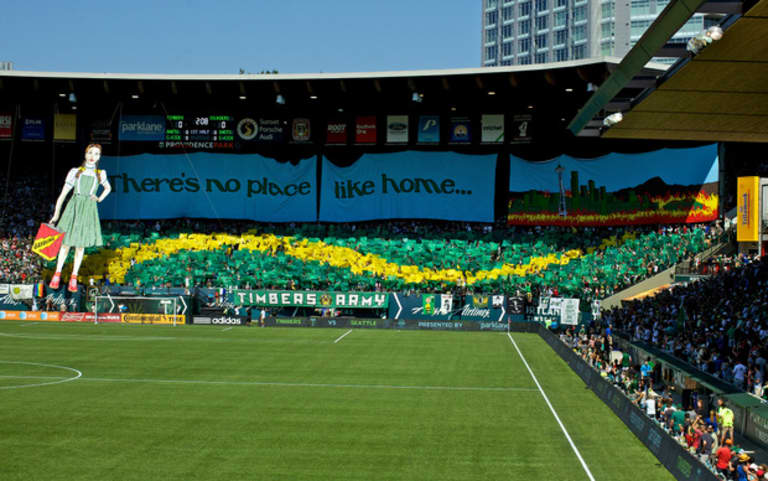
If the purpose of the tifo is often, in part, to encourage the home team while jabbing at opposition fans, the 90 minutes of solid singing is more a response to the game itself.
“We try to adjust to what's happening on the field,” Murray says. “We think of our songs as the soundtrack to the match. We try to set the tempo. We're telling team to push and fight. At set pieces we’re jumping and singing, ‘If you're not jumping you’re not Timbers,’ willing the players to win the header off the corner.”
Chanting is not limited to stadia. Unlike banners, fans carry them with them everywhere. The best songs often start in the pub as a joke, then catch on. It's also important for fans to assert themselves on the way to the game, on trains and in the street.
“It’s success and an occasion that gets the atmosphere going,” says John Brewin, a writer for ESPNFC in England who attends two or three games per week. “If a group of away fans get lairy [and riled up], that gets the home fans going.”
After the game against Real Salt Lake, the players lap the field, saluting the crowd and ending at the North End. The Timbers Army salutes back, though the overall feeling is a bit muted as the teams battled to a 0-0 draw. Sometimes a huge group effort can still lead to stalemate.
It takes a lot to organize a crowd and pull off two hours of sound and fury: Forming committees, running meetings, sourcing materials, renting warehouse space. And after the game it takes around three dozen volunteers half an hour just to clear the North End and stow the flags in the lock-up. But there’s another reason for going through this creative process of performance—one that has nothing to do with whether outsiders see artistic merit in the work, or whether the team performs well down on the field.
Singing and dancing, in public, for a shared cause: it just feels good. In Portland as in England, Brewin says, a sing-song is still a tonic. “If you went to a game, and you had a good sing, you’re taking control of the afternoon.”
-----------
Joseph Gallivan has covered music, technology, and arts and culture for the London Independent, the New York Post, and the Portland Tribune, where he is currently the business reporter. He is the author of two novels, Oi, Ref!and England All Over.
_Illustration: Noah MacMillan
_Photos: Craig Mitchelldyer











